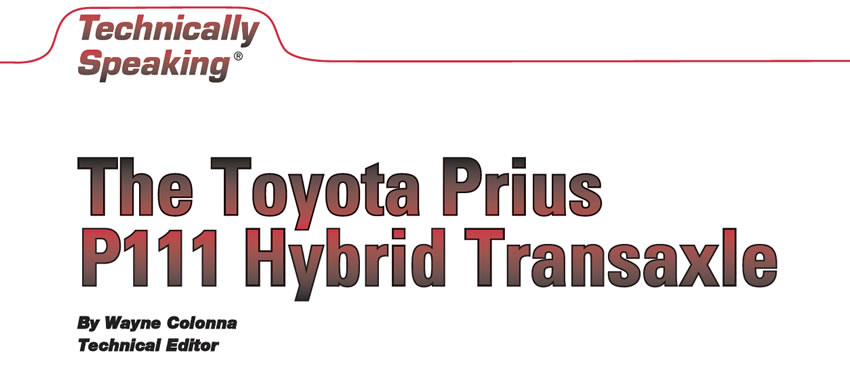Gaining a Little Insight
A parallel hybrid vehicle allows the power from a gasoline engine and an electric motor to drive the vehicle independently or in conjunction with one another. The Toyota Prius has such a design as well as the Honda Insight and the Civic Hybrid. Although they are all parallel hybrids, there are differing operational strategies between Toyota and Honda.

The Toyota Prius P111 Hybrid Transaxle
The Toyota Prius P111 hybrid transaxle shown in Figure 1 is a continuously variable transaxle. If you are already familiar with a Subaru Legacy or a Honda Civic HX, you might think this is another CVT with a belt and pulleys. Not this unit…

A Bouquet of Hybrids
Honda hit the road first with its gas-engine/electric-motor combo called the Insight, but it was Toyota that pioneered the “Hi Voltage Battery” technology and used it in its Prius vehicle. Ford broke ground by producing the first hybrid SUV with its 2003 Ford Escape. Ford also has plans in the works in which it will use the latest hybrid-electric-vehicle technologies with an advanced new fuel cell to produce the zero-emissions Ford Focus. Prototypes begin in 2004. Other manufacturers soon will have vehicles of environmentally friendly design available for purchase here as well. So it’s another technology that the auto-repair and rebuilding industry needs to prepare for.

The Upshift-Delay Dilemma
Several 1989-1995 Mercedes vehicles using the 722.3 or 722.4 transmission employ a device called the “upshift-delay vacuum actuator.” For this article, I will refer to it as the UDVA.

Even Failsafe Is Subject to Change
Since then, technology has leaped forward at a vicious pace, not breaking for breath. And with this technological race among the “Big 3” manufacturers (U.S., Japan and Europe) comes the need for various computer strategies. Failsafe is one of those strategies that has experienced a change.

Is Your 4WD Explorer Neutralizing?
But inside the transfer case closest to the transmission is the transfer direct-clutch drum that the sealing rings just love to dig into. The severity of the wear determines the degree of the complaint; i.e., delayed engagements, slipping or no movement. Technicians often misdiagnose this problem by blaming the transmission for the problem when all along it has been in the transfer case.

The SB or SSV – What’s The Difference?
Often, DTCs related to the solenoid switch valve (SSV) in any 41TE or 42LE transmission are misinterpreted as a problematic solenoid body (SB). This may be attributed to the use of the word “solenoid” in the code definition. Code 37 is the solenoid switch valve stuck in the TCC position, and 47 is the solenoid switch valve stuck in the L/R position. Either of these will place the transmission in “limp mode.” The solenoid switch valve is not in the solenoid body but in the valve body (see Figure 1).

A Case of Hide and Seek
One of the many automotive animals that technicians have to wrestle with is finding the definitions for the ever-increasing number of diagnostic codes. And then, of course, their definitions are being represented by a seemingly endless list of acronyms associated with that code. TCC, VSS and TPS are just a few recognizable acronyms in our industry today.

A Transfer-Case Identity Crisis
So in your ever-expanding list of causes for stacked upshifts in computer-controlled transmissions, even if it is a two-wheel-drive vehicle, investigate the possibility of a four-wheel-drive-low command being the culprit otherwise known as a transfer-case identity crisis.

Isuzu NPR/GMC Tiltmaster
The Isuzu NPR Commercial Truck and GMC Forward Tiltmasters use an exhaust-brake system that assists in engine braking during downhill coasting while the trucks are carrying heavy loads. This system is used instead of the familiar Jacobs Vehicle System known as the “Jake Brake.” When the exhaust brake is activated, it restricts the flow of exhaust with a flapper valve in the exhaust pipe similar to that of a heat-riser assembly (see Figure 1). When the flapper valve closes, exhaust pressure increases, causing air intake to decrease. This increased backpressure and slower air intake reduce torque transfer to the geartrain, producing the desired on-demand engine braking needed during downhill coasting with a payload.

Orbiting Saturn
The problem here is in the assembly of the 1st-clutch drum. At first glance, all four of the piston-return-spring assemblies look identical (see Figure 1). Each caged assembly contains 16 springs and has an average overall height of 1.170 inches. The size and configuration of the spring cage allow for these assemblies to be interchanged among drums.


